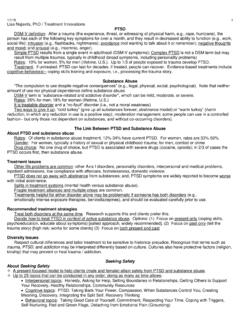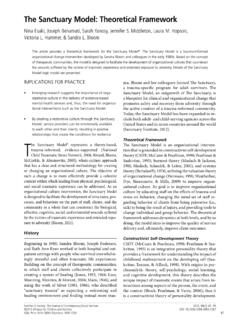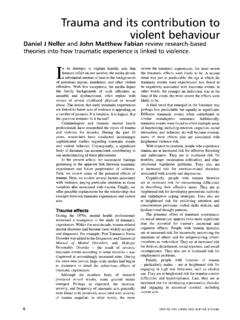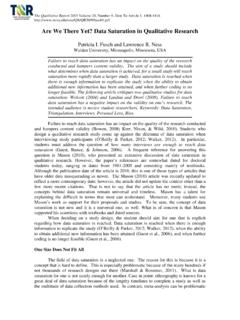Transcription of GREG’S SFBT HANDOUT - Useful Conversations
1 GREG S SFBT HANDOUT HANDOUT compiled by - Greg Vinnicombe Please feel free to photocopy though acknowledge the source 1 History of Solution Focused Brief Therapy (SFBT) and the Solution Focused Approach (SFA) The development of SFBT has been influenced by the findings (and discussions between) several researchers and practitioners over the past 60 years. Key to this process has been Milton Erickson, Gregory Bateson, John Weakland, Steve de Shazer and Insoo Kim Berg. Influential institutions include: The Mental Research Institute of Palo Alto and the Brief Family Therapy Centre in Milwaukee. In recent years, similar approaches have appeared Solution Orientated Therapy (Ahola and Furman) and Possibility Therapy (O Hanlon) that share with SFBT the concept of paying less attention to the problem and more attention to what already works and possible solutions. Further details of the SFBT history are contained in the last chapter of Jackson and McKergow (2002) Additional material is contained in Solution-Focused Therapy: Theory, Research and Practice (Macdonald AJ, Sage Publications, 2007) and Cade, B (2007) in: Thomas FN and Nelson T (Eds) Clinical Applications of Solution-Focused Brief Therapy Howarth Press: New York.
2 Is Solution Focused Brief Therapy? Solution Solutions not problems The worker attempts to assist the client in identifying what would be happening in the future when the problem is happening less or not at all. That is, solutions are built rather than problems are solved with an emphasis upon What is wanted (rather than what is not wanted) and detailing When this happens Who will be doing What? Also, the worker attempts to raise awareness in the client of those times that parts of the solution have occurred in the past or are occurring now. Focused Focused not forced. The worker and the client are focused upon a future where the problem does not exist, or is less of a problem, and on the times in the past and present , when the problematic events have not occurred. Note: There will be times when the client wishes to speak about the problem and at these times the worker should acknowledge the client s difficulties, as well as, looking for and commenting upon the client s abilities and strengths in coping with the problem.
3 Brief Not one more session than is necessary. The length and number of the sessions is agreed in partnership with the client. Both the client and the worker should be clear about what will be happening when the client no longer needs to meet with the worker. This can often be established in the first meeting. Thus, finishing is incorporated from the beginning and sessions are only as long as they need to be. Therapy Two people talking, with one trying to help the other. Essentially, the purpose of the session(s) is for the worker and client to engage in Conversations that are deemed Useful by the client. 2. The Solution Focused Approach in a nutshell Four Steps Three Principles 1 1. What do you want? a. If it ain t broke, don t fix it 2. How will you know when you have it? b. Once you know what works do more of it 3.
4 What are you doing already to get there? c. If it doesn t work, don t do it again: do 4. What would be happening if you were a something different little closer to what you want? GREG S SFBT HANDOUT HANDOUT compiled by - Greg Vinnicombe Please feel free to photocopy though acknowledge the source 2 2. Concept of Problem People seek help because they have a problem and want something to be better . Traditional approaches emphasise the problem and assume it is necessary to understand the problem before improvements can be made. In SFBT problems are just something that the client wants to do without, or something they want to do more of. In solution focused work, it is not essential to understand the problem in great detail before identifying possible solutions and given that the client has constructed the problem , they are in the best position to say when a problem has been resolved.
5 3. Useful Assumptions (or Beliefs or Presuppositions) in SFBT Usefulness is a key term in the application of SFBT and is elicited from the client s perspective of what is happening within, and between sessions, with the worker. Rather than having an overarching theory about the problem; SFBT is founded upon a set of assumptions which assist in generating questions that can prove Useful for clients. These assumptions include:- Assumptions about service users Every client is unique. Clients come to us with resources and strengths, both personal and in their social network. All clients have the ability to find their own solutions to the difficulties that they have. You cannot change clients; they can only change themselves. The therapist is not the expert on the clients and their social network, the client is A client s solution is more likely to fit their particular situation and more likely to be implemented and maintained.
6 Assumptions about problems No problem happens all the time; there are always exceptions that can be found and built on. A focus on the possible and changeable is more helpful than a focus on the overwhelming and intractable. The client is not the problem. The problem is the problem. The problem and solution occurs in the interaction between people rather than residing within people. Problems that appear complex, may not necessarily require a complex solution Assumptions about change Change is happening all the time Small changes can make a big difference Rapid change or resolution can happen when people hit on ideas that work There may well have been some pre-session change Assumptions about Practice Lasting change is more likely to happen when you find out what s working and help people figure out how to do more of it. Change is happening all the time. Our job is to identify and amplify Useful change. People are more likely to behave and/or think differently when you work with their goals for change (Wheeler, J.)
7 And Vinnicombe, G. (2011) Published as part of article in Context: the magazine for family therapy and systemic practice in the UK) GREG S SFBT HANDOUT HANDOUT compiled by - Greg Vinnicombe Please feel free to photocopy though acknowledge the source 3 4. SFBT Techniques To Promote Competence People s lives contain much more than the sum of their problems. In Problem Free Talk the worker attempts to elicit - and raise awareness within the client - details of their resources and strengths. It also establishes areas of competence rather than underlining incompetence - in the client s life. Additionally, the client s abilities from the past and present can be utilised to build solutions in the future and encourage a view of themselves and others that is helpful in promoting change. How do you usually spend your day? What parts of your work and home life do you enjoy? What do you do well? What interests do you have?
8 If the worker assumes change is happening all the time then change is likely to have taken place between the initial request for support and the first meeting with the worker. As this change has happened before the worker became involved; the client takes full credit for any changes that have occurred and progress that has been made. Additionally, inquiring about Pre-Session Changes can identify unsuccessful attempts to resolve the problem, which do not need to be considered again. What differences have you noticed occurring between the time that you decided to ask for help and today? What have you already attempted to do to reduce or eradicate the problem? Has any of this worked, even a little? Often times can be identified when the problem is not present , or is less influential in the client s life. Establishing these times can provide hope by demonstrating to the client that the problem is not fixed and hence it is not constantly occurring.
9 Exceptions also identify solutions that have been utilised in the past , or are presently being used. That is, behaviours that the client already, or has previously, utilised to cope with or lessen the effects of the problem can be acknowledged and repeated. Thus, the details of the Exception times are employed by workers in sessions to remind clients of what they are already doing, or have done, that works. When has this been less of a problem for you? Tell me the last time you did not (insert problem behaviour) when normally you would have done? What s been your best day at home or in work this week? Note: It is also possible at the initial referral stage (or in a letter confirming their place on a waiting list) to prompt clients to identify times when the problem is happening less or not at all. This information can then be acknowledged and utilised in the first session with the worker. Problem Free Talk Pre-session Change Exceptions 3 GREG S SFBT HANDOUT HANDOUT compiled by - Greg Vinnicombe Please feel free to photocopy though acknowledge the source 4 Some problems will persist for a period of time or become a fact of life.
10 These could include: awaiting a court outcome, having financial restrictions, experiencing a separation or death. Consequently, there may not be any Exceptions. Often clients can initially describe themselves as not coping with these circumstances and being unaware of their strengths and resources. Possibilities at such times include the worker eliciting these hidden behaviours by asking: What are you doing to cope with this? Over the past few days what has helped you to cope, even a little? What are the best that things can be I can live for two months on a good compliment. Mark Twain Throughout any meeting with a client SFA workers will be looking for opportunities to compliment the client on what they have heard and what the client has already done. Three ways of doing this are :- A. Directly I can see you re a persistent person, as you ve tried several different ways to find a solution (linking traits to behaviours) B.





